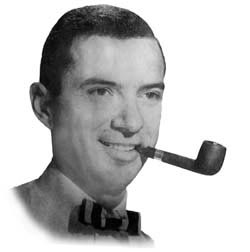|
|||||||||||||
|
|
Bill and his family illustrate the mobility of the dynamic “Golden Age of Aviation”. His family moved 19 times in their first 24 years of marriage. Bill is from New Jersey. His wife is from Massachusetts. Their first child was born in a three bedroom “hospital” in the Mojave Desert town of Lancaster, Ca. One other child was born in California and two more in Texas. Select here to view a news article and photos concerning Bill’s field service days published in the Dallas Morning News and the Dallas Times Herald on March 5, 1957. Bill was born Sept. 17, 1917 in Newark New Jersey. He attended public school in Newark. In 1934 he enrolled and spent one year at New York University. In 1935 Bill transferred to Rutgers University where he spent one year in Pre Medical school with a major in Chemistry. From 1936--1940 Bill helped his father in the family dry cleaning business. From 1940 – 1942 he attended The Academy Of Aeronautics in Newark New Jersey and graduated with an Associate Degree in Aeronautical Engineering. In 1942 Bill joined Vought Sikorsky Aircraft Co, at Stratford Connecticut which at that time was a division of United Aircraft. The years 1944 through 1949 were spent in Field Engineering where approximately 80% of his time was spent at Patuxant River Naval Aircraft Test Center where he represented Engineering in the testing of Vought products. During this period he spent an entire year in test work on the PA-6 which was Vought’s first missile program. In April of 1949 he was one of the last persons in the company to be resettled from Connecticut to Vought’s new location in Texas. Between 1949 and 1952 Bill was involved in the first launch and recovery of an unmanned guided missile in US history. In 1952 –1957 time period he conceived and managed the pilot production line and acceptance test for the Regulus I Missile Installation and Test Unit, (MITU) which was used to test the missile systems prior to delivery. During this period he also selected and managed the Missile Operation Engineers, (MOE’S). The Navy and Vought both felt that the successful introduction of a complex weapon such as Regulus required a higher level of Management personnel than that required for traditional airplane programs. The Navy felt so strongly about this that they allowed Management to be charged direct to the program rather then overhead as was the custom. From 1957 to 1961 Bill managed the Inland Test Range portion of the Pacific Test Range. This marked the first time a Government Test Range was ever contracted to a private corporation. In 1961 Bill assisted the Chairman of the Board of LTV make it’s first acquisition of a wholly owned subsidiary, Kentron. He was President then Vice president and General Manager of Kentron 1961-1963. While Vice President of Kentron he moved to the Naval Missile Test center at Point Mugu California to head a proposal team to bid on Managing the entire Pacific Missile Test Range. In 1964 LTV Management assigned Bill as consultant to the then State of Texas Governor John Conally to assist in the rehab of an old W.W.II Army Base as a “Job Corps” site. Duties included responsibility for complete restoration of all structures required for complete fulfillment of Job Corps objectives. With the help of the appropriate academic people Bill assisted in the structuring of course curriculums to enable enrollees to achieve entry level jobs in carpentry, plumbing, auto repair, culinary arts, commercial art, and heavy equipment operation. In 1965 at the request of the Chairman of The Board of LTV, Paul Thayer, Bill headed up a group of engineers in a study to ascertain the economic viability of Oceanography as a business activity. Later in the 1967-1968 as Director of Development Programs he determined and advised that Ground transportation was a good market for the company’s traditional skills. From 1968 to 1974 Bill was immersed in the sales, and development of the Ground Transportation System for the Dallas/Fort Worth Airport. His efforts began as a top level company representative to the designer of the Airport, Mr. Thomas M. Sullivan, before the first shovel of dirt was moved in the Airport construction. Working with Mr. Sullivan and LTV Engineering he coordinated the conceptual design of what was to become known as the Air Trans System to move people and cargo between the Airline Terminals. After the design, development and construction contract was awarded to LTV he continued in this relationship with Mr. Sullivan until the system was operational. Bill retired from LTV in April of 1974 at the successful demonstration of the Air Trans Concept.
|

 Bill Micchelli’s career at Vought spanned 32 years from 1942-1974. His Forte was the managing of off site programs. At various times in this career Bill was responsible for off site operations at the following locations. El Centro Ca, San Nichlos Island Ca, Point Mugu Ca, Edwards AFB Ca, Tonopah Nevada, Dugway Testing Grounds Utah, Port Hueveye Ca, San Diego Ca, Norfolk Va, Chincoteague Va, Venice Fla, Eglin AFB Fla, Roosevelt Roads NAS Puerto Rico, Kwajalen Atoll- Marshall Islands, Kaneohe NAS Hawaii, Bonhan NAS- Barking Sands, NASA Tracking Site-Kokee Park, Kauai Hawaii and the Naval Base at Pearl Harbor.
Bill Micchelli’s career at Vought spanned 32 years from 1942-1974. His Forte was the managing of off site programs. At various times in this career Bill was responsible for off site operations at the following locations. El Centro Ca, San Nichlos Island Ca, Point Mugu Ca, Edwards AFB Ca, Tonopah Nevada, Dugway Testing Grounds Utah, Port Hueveye Ca, San Diego Ca, Norfolk Va, Chincoteague Va, Venice Fla, Eglin AFB Fla, Roosevelt Roads NAS Puerto Rico, Kwajalen Atoll- Marshall Islands, Kaneohe NAS Hawaii, Bonhan NAS- Barking Sands, NASA Tracking Site-Kokee Park, Kauai Hawaii and the Naval Base at Pearl Harbor.